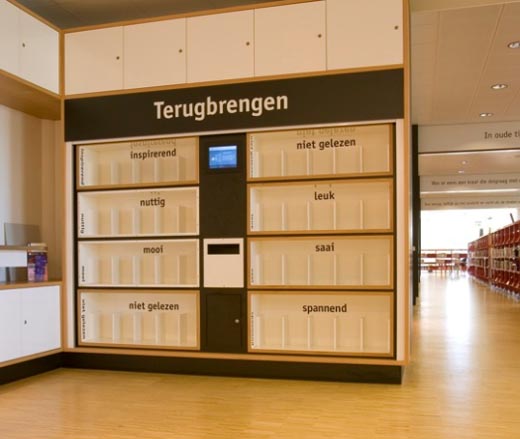
Nina K. Simon’s excellent paper, “Going Analog: Translating Virtual Learnings into Real Institutional Change,” describes how designers can approach integrating new user behaviors into existing ones — and why it’s often essential to do so. Simon argues that many designs fail to take hold because they ask users to adopt new practices or patterns of behavior that don’t in and of themselves add value to a particular experience. People are naturally reluctant to move outside of their accustomed flows, especially in well-defined spaces like museums, libraries, and schools. But what happens when a new technology comes along that promises great returns for users while simultaneously demanding some kind of additional input from them — in effect asking them to do step out of their flow and do something that they previously hadn’t done? Responding to this question, Simon provides the elegant example of the Bibliotheek Haarlem Oost, a branch library in the Netherlands that has developed a creative “in the flow” method for getting its patrons to tag the books in its collection:
http://remotedevice.net/blog/designing-interactions-in-the-flow-tagging-books-at-bibliotheek-haarlem-oost/Tagging has huge theoretical value to museums and libraries as a way to allow users to create folksonomies around institutionally-held collections, and there’s a clear mission connection for institutions whose goal is to engage visitors with collections and learning. While many museums are ably exploring the world of tagging on-line, no one has figured out how to make it work in the onsite visitor experience. Tagging could be very useful onsite if there were a way to access the tags and use them to discover artifacts of interest. Ideally, there would be a complete feedback loop where you would then be able to assign tags to objects as you view them in the galleries, thus creating more data for new visitors walking in the door.
What I’m describing maps to a complicated set of inputs and outputs. At the input (performing the tagging), visitors while onsite would need a way to mark individual exhibits with keywords. Then, on the output (using tags to access content of interest), visitors would need a way to scan the keywords at any exhibit, see linked related exhibits, and receive directional information to find the other exhibits. I can think of several ways to do this, and they all have long, painful lists of behavior changes associated with them.
The library at Haarlem Oost wanted to do this same thing – to allow patrons to tag the books they’d finished so they could be displayed on shelves and in the database for others to find books they might enjoy. But Hanrath didn’t come up with a clunky technology with lots of required behavior changes and instruction sets. They did something very, very clever. They installed more book drops.
The library created a book drop for a set of predefined tags (boring, didn’t read it, great, funny, exciting, good for kids, etc.). They also created shelves for the individual tags. When patrons return books, they place them on the shelves that appropriately categorize their books. Because the majority of books in the Dutch library system have RFID tags, the shelves were enabled with RFID readers that scan the books and add the tags to the books’ digital entries in the library database. The only behavior change required is for the patron to shelve his or her books in categories, and the benefit on the output side (the tags appearing in the library on-line catalogue) is immediate.
No patron would call the activity of putting their books in book drops ‘tagging,’ and that’s a good thing. There’s little concern here about barriers to use, educating the visitor on how to participate, or even significant infrastructure or support costs. The feedback loop is there, and it works because it’s a clever, simple distillation of the core idea of tagging. (Archimuse)



No comments:
Post a Comment